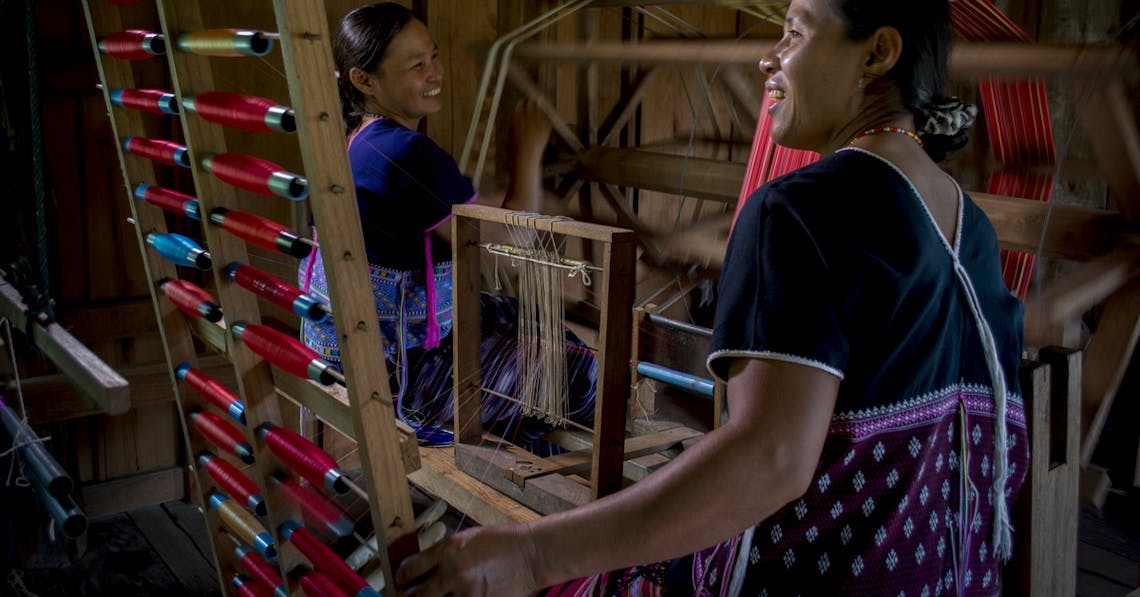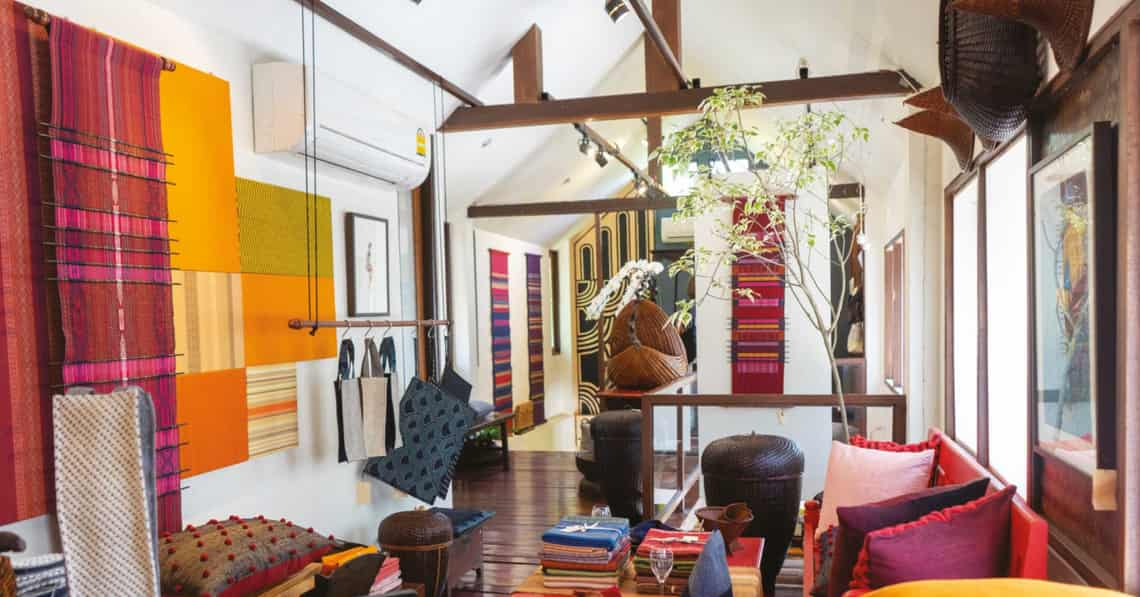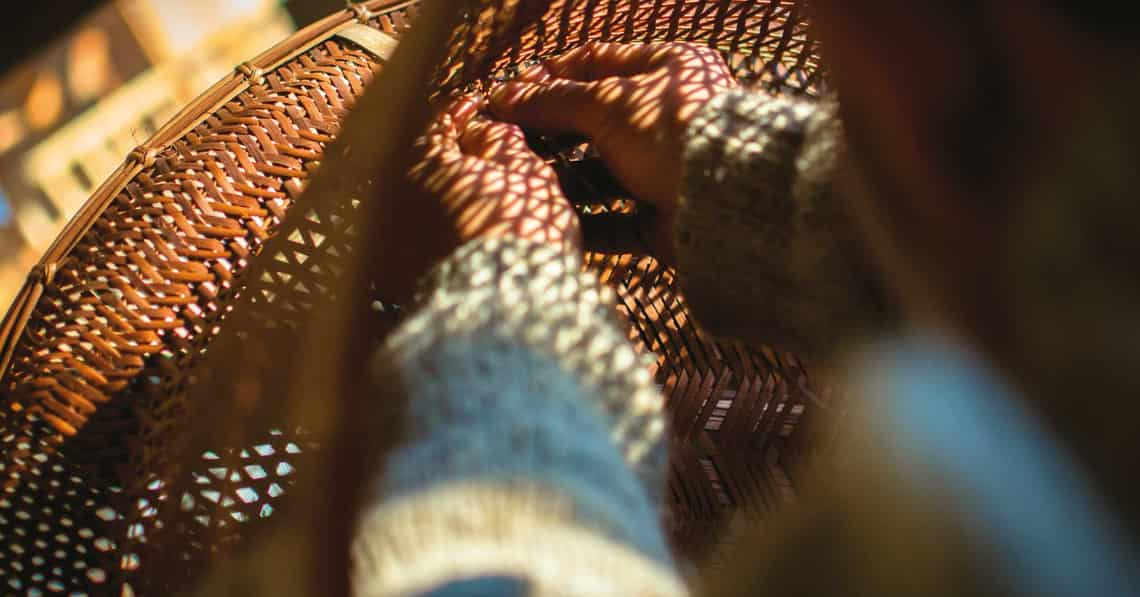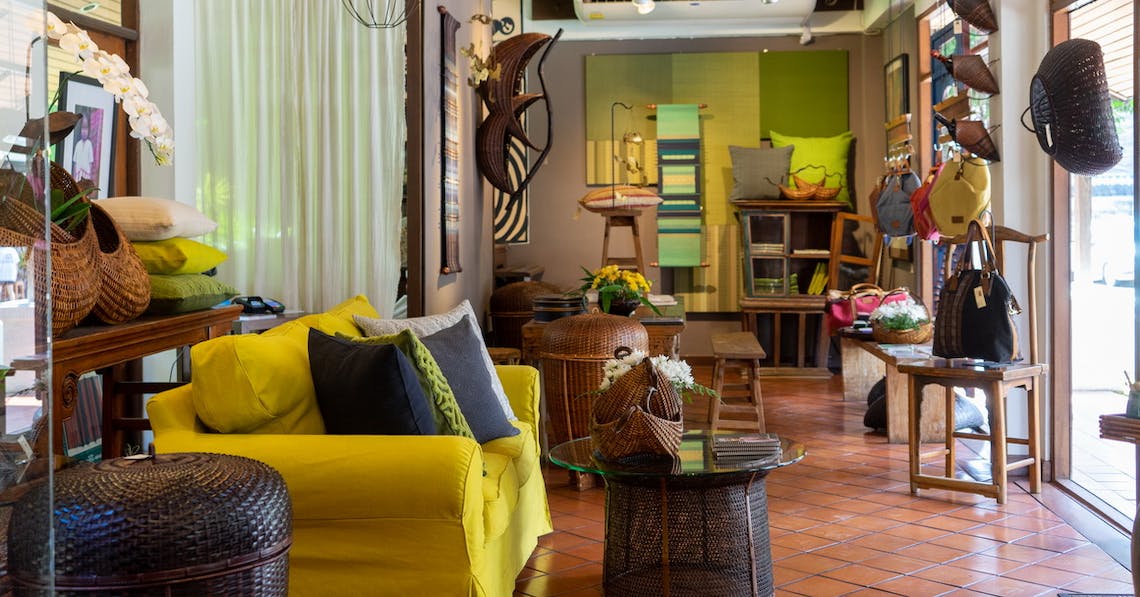Taciturn Kent Gregory, the man behind one of Chiang Mai’s most well-known luxury brands Sop Moei Arts, is impossible to pigeon-hole; his life-story (so far) reads like a an extraordinary swashbuckling tale from the 19th century yet he helms a non-profit enterprise which has been lauded world-wide for its high quality ethnic textile and basket weaving which have graced runways and magazine covers.
“I come from generations of medical missionaries,” said Gregory, as we sat down in a cosy corner of Sop Moei Arts boutique in Wat Gate, for a steaming cup of coffee, grown in the area his shop is eponymously named after. “My father, his many brothers, my grandfather, his many brothers, entire generations of our family had the essential agenda of proselytising and assisting people. It was very much a part of me,” explained Gregory who grew up in the south of Thailand where his father worked as a medical missionary.
“My family believed that we were born in this world to do something good, that we had to leave a mark,” he continued. “I chaffed at that but it was also a part of me, so while I do not follow the deeply religious Seventh Day Adventist roots of my family, I have found myself drawn to some of those beliefs.”
Having visited Chiang Mai as a boy, Gregory, who claims American and Thai citizenships, recalls visiting Doi Suthep Mountain and driving up a dirt road to a hill tribe village where he saw elephants dragging mired vehicles. “I was taken by the adventure and mystery of it all and it made a mark on me.”
Having severed his religious connections, Gregory returned to Thailand in the 1970s, following his Master’s Degree in public health with his Swedish wife, who had a similar degree, in tow.
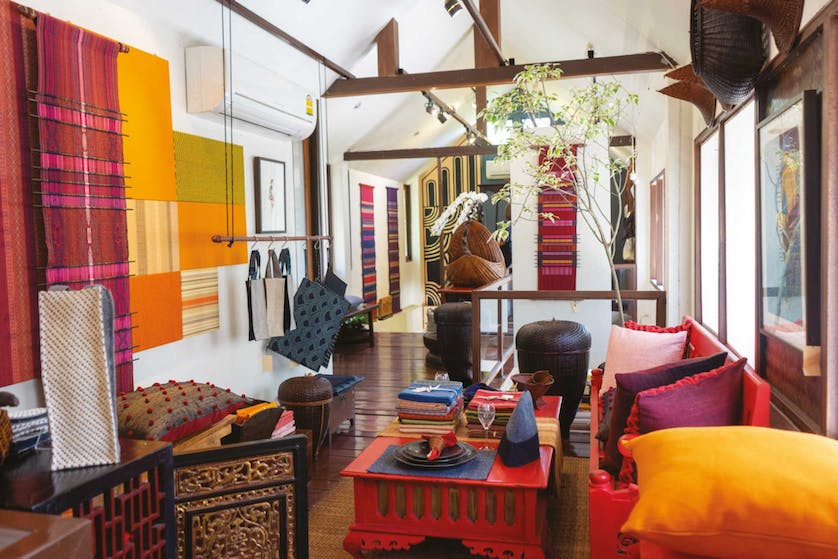
“I was always interested in anthropology and really wanted to learn a language of a people who were pre-literate, it was a real interest of mine,” explained Gregory of how he ended up living in the jungles of Mae Hong Son on the Myanmar border for nearly twenty years.
“The Karen are a big ethnic group, but there is a sub-group called the Pwo Karen, consisting of around 18 villages, who were cut off from the outside world, as there was no road access until 1988,” continued Gregory. “In 1977 we contacted the Thai public health and offered to help in remote areas which they had yet to penetrate. After a nine month survey, we discovered and identified the Pwo Karen cluster of villagers, agreeing to receive supplies from the public health office, but generating our own funding, which we received from Swedish International Development, our salaries akin to those working in the Peace Corps. It took two days’ travel from Chiang Mai, by car, boat and feet to arrive at the confluence of the rivers Moei and Youm, where people from the eighteen villages lived in near isolation from the outside world, united in their shared language, culture and animist beliefs.”
Over the next two decades the Gregory family expanded to include three children. They lived in a wooden house a twenty minute walk from the nearest village with no electricity or plumbing, the children being homeschooled by a rotating number of Swedish youths, paid a 2,000 baht stipend per month to spend a year living the adventure of a lifetime.
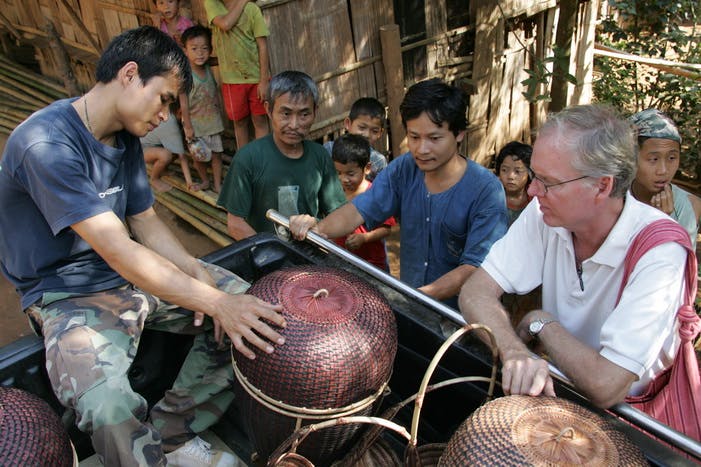
“There were tigers, leopards and bears in the area and we had two elephants which we used to carry medical supplies for us as we visited the villages in fortnightly rotations,” explained Gregory of a life which may sound terrifying to us city folk, but one which he said his family thrived on. Sadly, Gregory’s wife passed away in 1985, but Gregory said that it was easier being a single dad in the jungle than it would have been in the city, “I was a short walk from my weavers and my children. We all spoke Pwo Karen fluently, which was not easy when there were no books to learn from, the language being pre-literate.” Today one of his daughters, who works part-time on the enterprise’s social media, is married to a Karen man, and has made Gregory the proud grandfather of two.
After a decade of work, Gregory felt as though he was merely putting a band aid on the situation as malnourishment was still widespread. Infant and child death rates were high because slash-and-burn cultivation and hunting and gathering simply did not provide enough food for proper nourishment.
Having noticed that the Pwo Karen were exceptional weavers, Gregory contacted his Swedish funders to propose they develop and sell the craft as a way to earn cash so that the villagers could buy necessities. But nearby Thai market towns were poor and had their own weaving products, and sales prices so low they were hardly worth the effort, so Gregory took it upon himself to take the textiles down to Bangkok every few months to sell. While sales were brisk, it barely covered his travelling costs and the fine quality of weaving, while appreciated, didn’t stand out in any way to merit demanding higher margins.
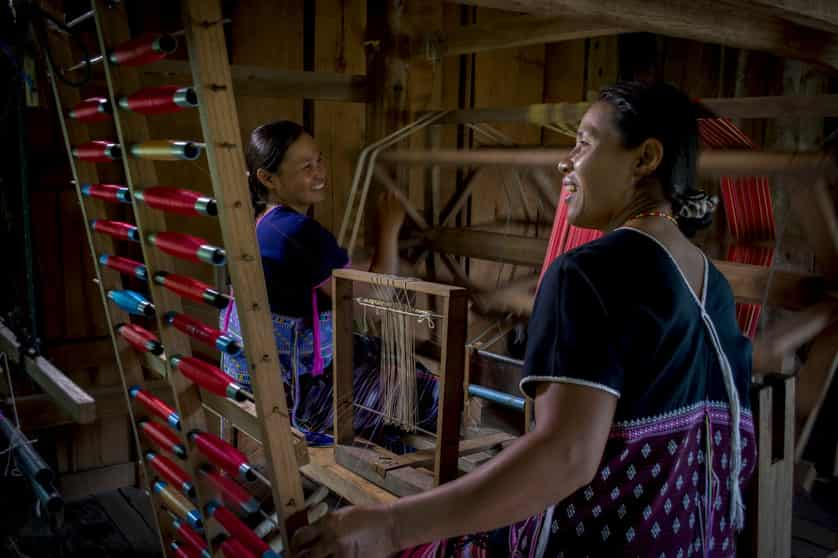
“One day as I was travelling home by boat up the nearby Salween River, I met an English lady,” continued Gregory. “I don’t normally approach strangers, but she was such an anomaly there in the middle of nowhere I asked her what she was doing. She told me that she was a designer from the UK and that she was tasked by Oxfam to spend six weeks working with the nearby Karen refugees who had settled on the Thai border to help them develop their sewing skills. Thinking that she may run out of tea at some point, I invited her to come and visit us, and sure enough she turned up that weekend for a visit. I showed her the textiles we were producing and asked her to help come up with some colour combinations on index cards. Two hours later she had put together some colours which really worked together. That was the start of something quite special and over the next six years she returned each year for a few weeks to help our women. The Swedish government would pay for her travel, she would be able to take the textiles our women worked on home with her and we would be allowed to replicate her ideas.”
Her name was Dorothy Reglar and her garments had been featured in Vogue magazine. For years she came and did things with colour and textiles which Gregory said he never thought was possible; mixing colours, textures and fabrics, and weaving components together that he had never seen matched.
“My job was to make the weavers understand,” continued Gregory. “So when we had a nice collection in the first year I took them down to Thai Crafts, a trade event in Bangkok, and they flew off the shelf. A lightbulb went up and I thought, ‘Aha! Colour matters.’”
This was around 1990 and suddenly the women were being paid with cash in hand immediately after finishing a product, Gregory paying per metre, depending on complexity of textile. He would go to Bangkok every four to six weeks, bringing back more orders. What started with ten weavers soon grew to 60 weavers across six to seven villages. By 1994 demand was high, but with no electricity or telephone cables, there was no way for buyers to get in touch with Gregory, so he received his last fund from Sweden, 60,000 baht to pay the first month’s rent on what is now Sop Moe Arts, in Wat Gate.
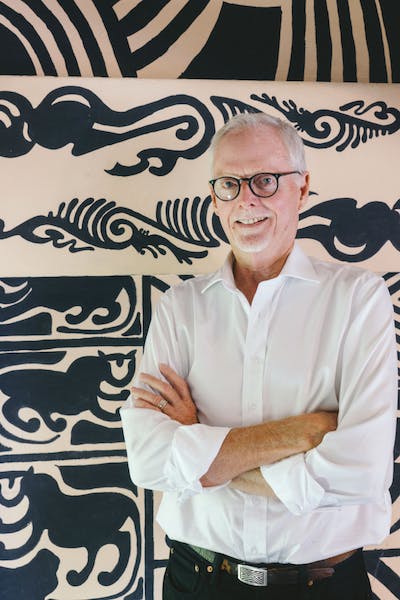
“The first thing we saw was that they were beginning to buy better supplementary food and that their houses began to get better,” said Gregory, who says that Sop Moei Arts is a social enterprise, with all profits going back to the community, whether in form of payment for production, scholarships for children or other support. “The families who were working with us became visibly better off. Even though weaving was a women’s domain, we soon saw men begin to weave, as their wives were making cash they couldn’t. The top weaver could earn up to 18,000 baht in one month. What we did do was that we gave them money to be able to invest in things. We gave them seed money for things such as telephone service; they opened shops and offered international phone services to the neighbouring refugees. It kick-started the local economy.”
The Sop Moei Arts success story was spreading far and wide by the late nineties, with designs being lauded, the exotic story of Gregory and the Pwo Karen being hailed by the press, and even Her Royal Highness Queen Silvia of Sweden came for a visit, saying, “I came to Sop Moei with my husband, the King, and two of our children around New Year 2003…One fact that we learnt from our visit to Sop Moei is the difference that a small-scale development project can make, not only for the standard of living, but also for the self-esteem and personal security of the individual.”
One day Gregory had another idea. He saw the men going into the forest, carefully pick bamboo and weave exquisite baskets for daily use; whether to store pumpkin seeds, carry goods or clothes, or use as mats. The Sop Moei men were fine basket weavers. Soon he had set up yet another cottage industry, strictly controlling the quality of a variety of baskets which were lovingly woven, smoked and lacquered, starting with traditional designs, but soon branching into special patterns and designs unique to Sop Moei Arts.
“I began to realise that basket weaving was a dying art throughout the region,” explained Gregory, who travelled extensively throughout South East Asia collecting a variety of baskets from various tribes and peoples, bringing them back to his Sop Moei artisans to faithfully replicate. At one time, 100 men were weaving over 80 models of baskets which sold in his shop and at various outlets. Today there are five weavers remaining.
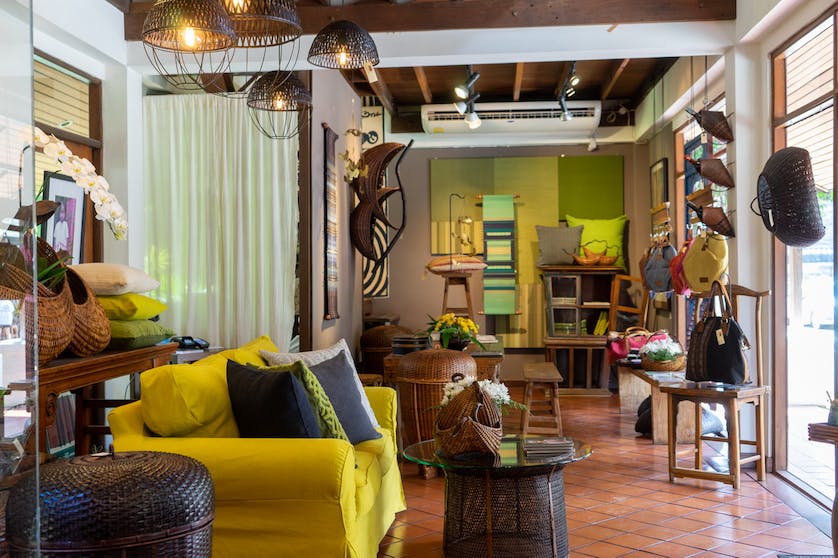
“It is sad now though, we have seen a sharp drop of products and sales in recent years,” said Gregory, shaking his head. “The lure of the big city means that fewer people are interested in sitting in their village weaving, however lucrative. The Karen are not motivated by money, but when the world opened up, many wanted to go see it. Just because they were weavers doesn’t mean that they actually liked it. They were finally doing new things. It was ‘wow’!”
In 1998 the road reached the Sop Moei area and by 2002, two massive Karen refugee camps settled in an area not far from Sop Moei and the area became flooded with NGOs. This was when Gregory ended his medical work completely. Up until then, he had continued to take his two elephants around the villages setting up temporary clinics to help malnourished children and new mothers.
“The worst thing I could have imagined being was a businessman,” smiled Gregory. “But this is worth doing. My interpretation is that if it wasn’t for the people up the mountains [this would not have happened]…they are the driving motivation. We feel as though we helped push for improvement. It is their choice now what to do. They have choices now.”
Sop Moei Art is still a brand to be reckoned with, in spite of challenges in supply. Their kaleidoscopic cushions, bags, and fine baskets fetching a fine price at their Chiang Mai and Bangkok stores. He cites the fact that all of his children have gone on to university where they have excelled, as a great source of pride. He regularly visits his Sop Moei family, although most of the people he worked with have moved down to the valley so that their children can get a better education. Sitting in his wooden shop, surrounded by rich and luxurious fabric created by the people he spent his life helping, Gregory appears contentment.
